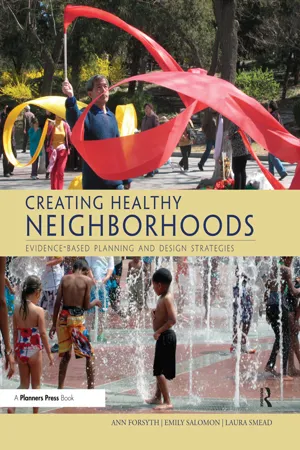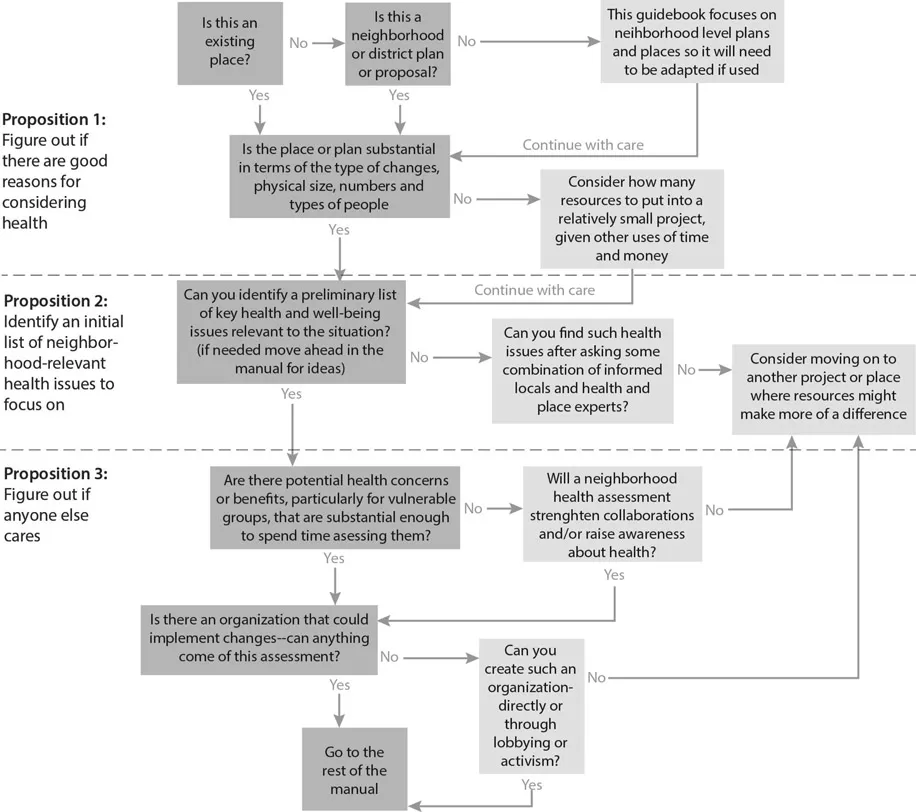
eBook - ePub
Creating Healthy Neighborhoods
Evidence-Based Planning and Design Strategies
This is a test
- 264 pages
- English
- ePUB (mobile friendly)
- Available on iOS & Android
eBook - ePub
Creating Healthy Neighborhoods
Evidence-Based Planning and Design Strategies
Book details
Book preview
Table of contents
Citations
About This Book
Good housing. Easy transit. Food access. Green spaces. Gathering places. Everybody wants to live in a healthy neighborhood. Bridging the gap between research and practice, it maps out ways for cities and towns to help their residents thrive in placed designed for living well, approaching health from every side – physical mental, and social.
Frequently asked questions
At the moment all of our mobile-responsive ePub books are available to download via the app. Most of our PDFs are also available to download and we're working on making the final remaining ones downloadable now. Learn more here.
Both plans give you full access to the library and all of Perlego’s features. The only differences are the price and subscription period: With the annual plan you’ll save around 30% compared to 12 months on the monthly plan.
We are an online textbook subscription service, where you can get access to an entire online library for less than the price of a single book per month. With over 1 million books across 1000+ topics, we’ve got you covered! Learn more here.
Look out for the read-aloud symbol on your next book to see if you can listen to it. The read-aloud tool reads text aloud for you, highlighting the text as it is being read. You can pause it, speed it up and slow it down. Learn more here.
Yes, you can access Creating Healthy Neighborhoods by Ann Forsyth, Emily Salomon, Laura Smead in PDF and/or ePUB format, as well as other popular books in Architecture & Urban Planning & Landscaping. We have over one million books available in our catalogue for you to explore.
Information
Principle 1
Importance
Assess how health matters in this place.

Information is needed to start investigating a project or place and figure out if health is a useful lens for understanding and improving it. For an existing place—how to make it better? If making or reviewing a proposal—how can it be made healthier?
How It Works
A planning process is starting. A community group wants to improve its neighborhood. A city government aims to redevelop a mixed use district. In each of these cases planners, policy makers, civic leaders, business people, and residents may be interested in incorporating health issues into their activities. This raises questions. What specific health-related issues are in play? Who might be affected? If you identify changes to improve positive health outcomes or reduce negative ones, is there any way to make a difference? Because it takes resources to investigate health issues, are there allies and funding sources?
To start answering these questions, dealt with in subsequent propositions, information is required—about the place or proposal, health concerns, the role of environment in those concerns, and the people and organizations who can make decisions about the place. We refer to the process of collecting this information and reviewing projects, plans, and proposals as a neighborhood health assessment. In the planning and public health disciplines, a health assessment can take many forms and can be customized to meet the needs of the community.
The kind of health assessments most likely to be used includes health impact assessment and healthy community assessment. In a formal health impact assessment the processes of answering some of these questions are called screening (to see if it is worth doing an assessment) and scoping (to determine what to assess).1 It is often done prospectively, examining a draft project, policy, or plan to identify how to make it better. This book can be used in this way, but it can also be used to assess existing places, plans, programs, and policies to establish goals for making changes. Health impact assessment can be done in a range of ways from the highly participatory to the more technical and quantified to hybrids that combine approaches; they can be short desktop exercises to months-long processes.
Healthy community assessment is a term used to describe a community-based assessment of an existing community that helps residents prioritize health and well-being concerns, develop organizational skills, increase understanding, and act collectively.2 While many communities are larger than a neighborhood, or not spatially defined at all, this kind of process can occur at the neighborhood level and involve a variety of stakeholders.
These both differ from more traditional community health needs assessments that evaluate the level of health of a population, identify risk factors, and outline preventive measures.3 Commonly conducted in public health, these can be extremely useful background studies, though they are generally focused on a wider geographical areas than a neighborhood and a public health toolkit of interventions such as vaccinations or education campaigns.
Figure 8 is a decision tree showing how a neighborhood health assessment might be done as

Figure 8. Questions about projects, places, and health
The questions in the dark gray boxes, clustered by propositions in this principle, can help decide if and how to incorporate health into planning efforts and projects. They are relevant to planners, policy makers, civic leaders, and activists weighing how to make the biggest impact with potentially available resources.
Source: Developed by authors
part of a planning, design, or redevelopment process. Subsequent propositions provide more detail.4
The decision tree does not need to be followed exactly, but it provides a broad sense of the kinds of questions to ask and also the scope of this book—focused on neighborhood and district-level projects, plans, and places. It starts with questions about the kind of place or project, moves to potential health topics, and then focuses on whether an assessment will make a difference. If it will not make a difference, it may not be worth doing unless desired as a learning experience. While it may seem that health is always important, it makes sense to expend effort where you can make a difference. For this reason, at several points the decision tree suggests moving on to another project, plan, or place.
This raises some issues of terminology. The key distinction in this book is between assessing physical places and assessing the rest—spatial plans about specific future actions in a place, projects focus...
Table of contents
- Cover
- Half Title
- Title
- Copyright
- Contents
- List of Figures
- List of Tables
- Acknowledgments
- Introduction: Toward Healthy Neighborhoods
- Principle 1. Importance: Assess how health matters in this place
- Principle 2. Balance: Make healthier places by balancing physical changes with other interventions to appeal to different kinds of people
- Principle 3. Vulnerability: Plan and design for those with the most health vulnerabilities and fewest resources for making healthy choices
- Principle 4. Layout: Foster multiple dimensions of health through overall neighborhood layout
- Principle 5. Access: Provide options for getting around and increasing geographic access
- Principle 6. Connection: Create opportunities for people to interact with each other in positive ways
- Principle 7. Protection: Reduce harmful exposures at a neighborhood level through a combination of wider policies and regulations along with local actions
- Principle 8. Implementation: Coordinate diverse actions over time
- Conclusion
- Appendix A: Actions checklist
- Appendix B: Health topics by section
- Notes
- References
- Index